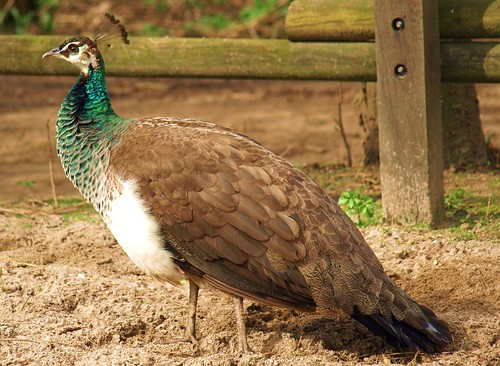
As we have evolved, like other population, we evolve by natural selection. A big part of that selection is sexual. Since genes are what are passed onto the offspring they are what truly determine the characteristics that are displayed in the phenotype of the majority of the population. Our distant ancestors looked much different than we do today because they were still evolving and adapting to their environment and the sexual preferences of the opposite sex. Why we are attracted to the things we are attracted to is discussed in an article entitled “Theory of Sexual Selection - The Human Mind and the Peacock’s Tail” by Caspar Hewett.
In this article Hewett compares the development of the human mind to the development of the tail of the male peacock. The reason that the tail of the peacock is so gaudy and brightly colored is because the female peacock prefers the brighter male peacock to the more drab colored males when choosing a mate. The fact that the peacock’s tail was brighter meant that the peacock was in more danger from predators. But then again it does not matter how long you survive if you don’t reproduce because if you don’t reproduce then you don’t pass on your genetic material and your fitness is zero. So although the dully colored male peacocks potentially survive longer than the brightly colored ones will not be shown in future generations to come if they never mate. 
The next question was why do female peacocks prefer the brighter colored males? What is the advantage to the male having a brighter tail? Different speculations were made but the most convincing one was that the bright color of the males actually represented a more important character trait. That being that the males with the more brightly colored tails were stronger and healthier than the dully colored ones. This would mean that the offspring produced would inherit stronger and healthier genes. The evolution of the coloration of the male peacock seems to be pointless if not deleterious to the male peacock, but with further investigation it is shown that the female’s preference for the brighter males was not a superfluous partiality.
As male peacocks used to have dully colored tails human both male and female had smaller brains. One of our older ancestors only had a brain the size of 400cc. The size of the brain of men and women today is 1400cc. This is a gigantic brain in proportion to the size of the human body, and almost seems unnecessary. Just like there are advantages for a peacock to have a more brightly colored tail there is an advantage for humans to have large brains.
One reason given in this article for the brain being larger is the preference for more juvenile looking beings. This is the idea of neotony where the adult form of a organism retains many if not all of the characteristics of the infant. The larger brain would make the development period longer and we would retain the more juvenile or infant like characteristics. The Machiavellian hypothesis is also brought up as a reason for the larger brain in humans. This hypothesis is the idea that the brain is larger because it evolved that way through human competition. Through this competition different abilities were developed. Some examples of these abilities are being able to be deceitful and the fact that we have a subconscious. Another reason given why the brain in humans is bigger is because we are more attracted to intelligence.
In this article it is suggested that the preference for intelligence was a random occurrence and that is why we don’t see this evolutionary path in other apes that we are closely related to. We also have a very different mating style than apes do. Humans, for the most part, practice monogamy and the two parents raise their child/children throughout their lives. This different mating practices and inclinations lead us to have many different affinities than apes. So our brains have adapted via natural selection to the way we live our lives.

Caitlin,
ReplyDeleteWhat an interesting paper! I printed off a copy for myself - thank you for introducing it to me. I am glad that you pointed out the seeming discrepancy between the work of natural selection and that of sexual selection. Sometimes the two seem to be at odds, and the peacock is a perfect example of that.
Dr. Evans has a book called "Our Inner Ape," which is very good and addresses the mating systems of chimps and bonobos, our closest relatives. Just a thought...
-Dr. Walker